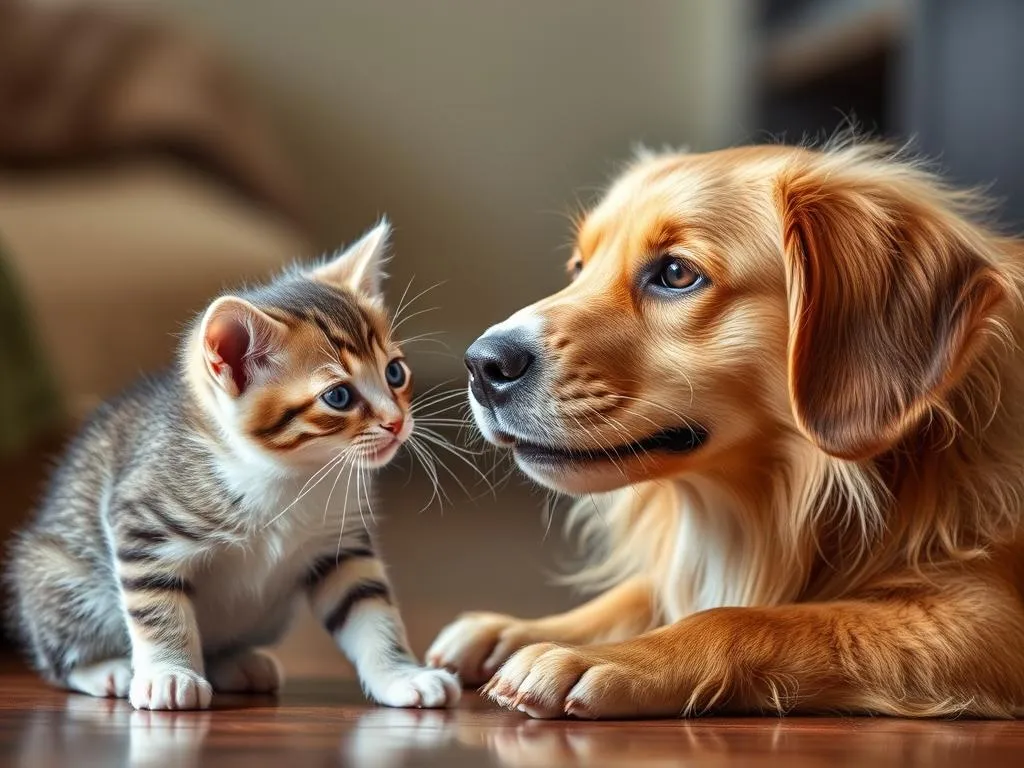
Introduction
Introducing a new kitten to your dog can be an exciting yet daunting experience. The dynamics between cats and dogs can vary widely, and understanding how to introduce a kitten to your dog properly is essential for fostering harmony in your home. A smooth introduction not only benefits your pets but also enhances your living environment, making it a joyful place for all family members.
When done right, having both a dog and a cat can enrich your household, providing companionship, entertainment, and love. This article will guide you through the process, from understanding your pets’ personalities to ensuring a long-term harmonious relationship.
Understanding Pet Personalities
Recognizing Dog Behavior
Every dog has a unique personality shaped by breed and individual temperament. Understanding these common dog instincts is crucial when considering how to introduce a kitten to your dog.
- Instincts: Many dogs have strong prey drives, meaning they may instinctively chase smaller animals. Breeds like terriers and herding dogs may exhibit stronger instincts than others.
- Socialization: Dogs that have been well socialized with other animals, including cats, tend to adapt better to new introductions.
Understanding Kitten Behavior
Kittens are naturally curious and playful, but their behavior can differ significantly as they grow.
- Natural Instincts: Kittens may see dogs as big playmates or potential threats, depending on their experiences.
- Socialization Stages: The first few weeks of a kitten’s life are vital for socialization. A well-socialized kitten is likely to be more confident and adaptable when meeting new pets.
Assessing Compatibility
Before introducing your kitten to your dog, it’s essential to assess their compatibility.
- Dog Signs: Look for signs that your dog may be more accepting of a kitten, such as a calm demeanor and previous positive experiences with cats.
- Kitten Temperament: Evaluate your kitten’s temperament. A bold kitten may adapt quickly, while a shy kitten may need more time to adjust.
Preparing for the Introduction
Creating a Safe Space for the Kitten
Establishing a safe space for your new kitten is paramount before the introduction.
- Private Area: Designate a room where your kitten can retreat and feel secure. This area should have everything your kitten needs, including:
- Litter box
- Food and water bowls
- Toys for playtime
- Safety Protocols: Ensure this area is free from hazards and has minimal access for your dog until the introduction is complete.
Preparing Your Dog
A well-trained dog is essential for a successful introduction.
- Obedience Training: Make sure your dog knows basic commands like “sit,” “stay,” and “leave it.” This will help you manage their behavior during the introduction.
- Calming Techniques: To reduce excitement or anxiety, consider engaging your dog in a long walk or play session before the introduction, so they are more relaxed.
Gathering Supplies
Having the right tools can make the introduction smoother.
- Leash and Treats: Use a leash to maintain control over your dog during the first interactions. Treats can help reward good behavior.
- Barriers: A baby gate can be a useful tool for creating a safe space between your dog and the kitten during initial meetings.
The Introduction Process
Step-by-Step Introduction
The introduction should be a gradual process.
- Scent Introduction: Start by allowing your pets to get familiar with each other’s scent. You can do this by swapping blankets or toys between the two.
- Controlled Meeting: After a few days, set up a controlled meeting. Use a leash on your dog and place the kitten in a carrier or behind a baby gate to observe each other without direct contact.
Observing Body Language
Understanding body language is crucial in this process.
- Dog Body Language: Look for signs of stress or aggression in your dog, such as growling or stiff posture. If you notice these signs, it may be best to separate them and try again later.
- Kitten Reactions: Kittens may display fear or curiosity. Watch for signs like hiding, purring, or playful posturing.
Managing Interactions
Monitoring their interactions closely will help ensure safety.
- Face-to-Face Meetings: When the time comes for a face-to-face meeting, keep it short and positive. If either pet shows signs of distress, calmly separate them and try again later.
- Short Interactions: Gradually increase the length of their interactions as they become more comfortable with each other.
Reinforcement and Training
Positive Reinforcement Techniques
Rewarding good behavior during the introduction is vital.
- Using Treats: Offer treats and praise to both your dog and kitten when they exhibit calm behavior around each other. This will help create a positive association.
- Playtime: Engage them in play together with toys that promote interaction, fostering a bond over shared activities.
Ongoing Training for Your Dog
Training doesn’t stop once the introduction is complete.
- Commands: Reinforce commands that help maintain control during interactions, such as “leave it” when the dog gets too curious about the kitten.
- Consistency: Regular training sessions will help ensure your dog remains well-behaved around the kitten.
Socialization for the Kitten
It’s essential to encourage positive experiences for your kitten.
- Exploration Encouragement: Allow your kitten to explore areas where your dog has been, under your supervision, to help them become accustomed to each other’s presence.
- Gradual Interaction: Gradually increase the time they spend together, ensuring both pets remain comfortable.
Monitoring Behavior Over Time
Signs of Progress
As your pets acclimate, you’ll notice positive changes.
- Positive Behaviors: Look for signs of progress, such as your dog being calm around the kitten or the kitten seeking out the dog to play.
- Adjustment Timeline: Remember that adjustment can take time, and every pet is different. Be patient and observant.
When to Seek Help
If things aren’t going smoothly, it might be time to seek professional help.
- Professional Support: If your dog shows persistent aggression or your kitten remains fearful, consulting a professional trainer or behaviorist can provide tailored strategies.
- Resources: Seek out local training classes or behaviorists who specialize in multi-pet households for further assistance.
Tips for Long-Term Harmony
Maintaining Separate Spaces
Creating boundaries is essential for peace in a multi-pet household.
- Personal Areas: Ensure both pets have designated areas where they can retreat to feel safe and secure.
- Shared Spaces Management: When allowing shared access to common areas, supervise closely to prevent any potential conflicts.
Regular Routine and Structure
Establishing a routine helps both pets feel secure.
- Daily Schedule: Develop a daily routine that includes feeding, playtime, and training sessions for both pets. This routine will help them understand what to expect.
- Bonding Activities: Engage in regular bonding exercises that involve both pets, like interactive play sessions or training games.
Keeping Up with Socialization
The introduction process doesn’t end after the initial meetings.
- Continued Socialization: Continue socializing both pets even after they seem comfortable. Regular interactions can reinforce their bond.
- Interactive Activities: Plan activities that encourage both pets to interact in a fun and safe manner, such as supervised playdates or joint training sessions.
Conclusion
Introducing a kitten to your dog is a process that requires patience, understanding, and planning. By recognizing the unique personalities of your pets, preparing adequately, and monitoring interactions, you can foster a peaceful coexistence between them. Remember that every pet is different, and adjustments may take time. Your commitment to their well-being will ultimately lead to a harmonious household filled with love, laughter, and companionship. Embrace the journey, and enjoy the rewarding experience of watching your dog and kitten grow together!









